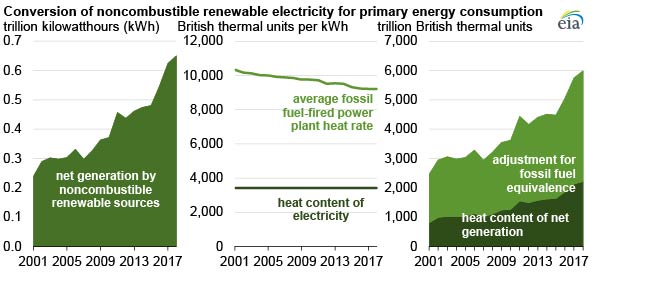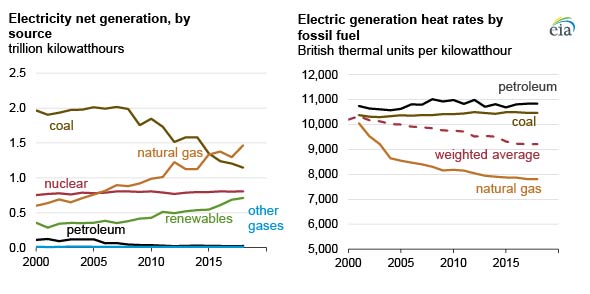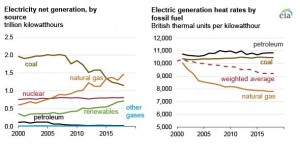
The share of electricity generation from noncombustible renewable energy sources—solar, wind, hydro, and geothermal—for power generation is increasing. To compare the energy consumption for electricity from noncombustible renewable sources with other energy sources, the U.S. Energy Information Administration (EIA) offers two approaches: the fossil fuel equivalence approach and the captured energy approach. The choice of approach may serve different analytical or statistical needs.
In 2018, the fossil fuel equivalence approach showed that primary energy consumption for electric power generation from noncombustible renewable sources was equal to consuming 5,989 trillion British thermal units (Btu), or 15% of the total energy consumption for utility-scale electricity generation in that year. This value includes 2,218 trillion Btu of energy transformed into electricity based on the constant heat content of electricity and an adjustment of 3,771 trillion Btu to reflect the weighted average heat rate for fossil fuel-fired power plants.
EIA estimates total primary energy produced and consumed in the United States. To compare contributions by various sources, estimates of total energy must be in a common unit. EIA uses the energy content of the source measured in British thermal units, which are derived from the underlying heat content of fuels reported to EIA in physical units. The heat contents of fossil fuels and combustible renewables are based on how much heat is produced from burning coal, oil, natural gas, or biomass energy. For nuclear energy, primary energy is measured as the heat produced from nuclear fission in the reactor core. Noncombustible renewables are a special case because energy is extracted without burning a fuel.
Noncombustible renewables generate electricity by converting energy—such as the kinetic energy in flowing water and solar radiation—into electricity. Because energy can be extracted from water, wind, solar, and geothermal without combustion, heat losses as a result of electricity conversion are negligible. Energy losses for noncombustible renewable electricity are based primarily on how efficiently the generator can gather and convert available energy into electricity. Unlike combustion fuels, which are bought and sold based on intrinsic heat value and physical quantity, noncombustible renewable resources have no direct economic value. As a result, EIA calculates primary energy consumption by converting kilowatthours produced by noncombustible sources to heat.
Traditionally, EIA used the fossil fuel equivalency approach to report noncombustible renewables’ contribution to total primary energy, in part because the resulting shares of primary energy are closer to the shares of generated electricity. The fossil fuel equivalency approach applies an annualized weighted-average heat rate for fossil fuel power plants to the electricity generated (in kilowatthours) from noncombustible renewables. This calculation also represents the energy that would have been consumed if the electricity from renewable sources had instead been generated by a mix of fossil fuels. Without adjusting primary energy for fossil fuel equivalence (see above chart), the noncombustible renewable share of total energy consumption for utility-scale electricity generation would be 6% in 2018 instead of the 15% share under the fossil fuel equivalency approach. On a physical units basis, net generation from noncombustible renewable energy sources was 650,008 thousand megawatthours, or 16% of total utility-scale net generation, in the same year.

EIA calculates the fossil fuel equivalency factor using heat rates reported by generators on the Form EIA-923 survey, Monthly Generation and Fuel Consumption. The heat rate of a power plant measures the total heat input required to produce a unit of electricity, typically expressed as Btu per kilowatthour (Btu/kWh). Although some energy is lost when consuming fuel as a matter of physical laws, lower heat rates indicate more efficient generation because it takes less fuel to generate a kilowatthour of electricity. EIA calculates the fossil fuel equivalency factor as an annual weighted-average heat rate for all generators to account for geographic and operational differences.
As newer, more efficient plants have been added to the mix, the weighted average heat rate of fossil fuel generators has declined since 2001. Natural gas generation from newer combined-cycle plants is more efficient than traditional steam generation, and combined-cycle units continue to improve in efficiency. This increase in efficiency from combined-cycle units has led to a decline in the average heat rate of fossil fuel generation from 10,333 Btu per kilowatthour in 2001 to 9,213 Btu per kilowatthour in 2017, an 11% improvement, as shown above.
EIA also publishes an alternative estimate of primary energy from noncombustible renewable electricity using the captured energy approach. Captured energy is the net energy available for direct consumption after a noncombustible renewable resource transforms into electricity, not including conversion losses. The captured energy approach does not adjust the constant heat content of electricity (3,412 Btu/kWh). EIA often uses this approach to compare electricity consumption to other fuels consumed by end uses such as space heating and appliances.


Follow us on social media: